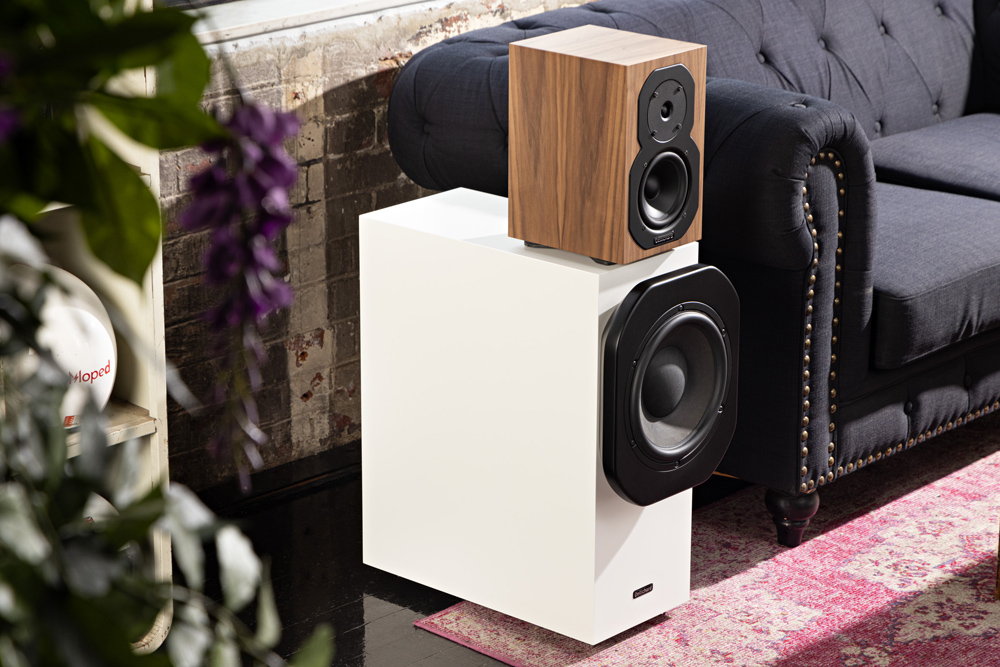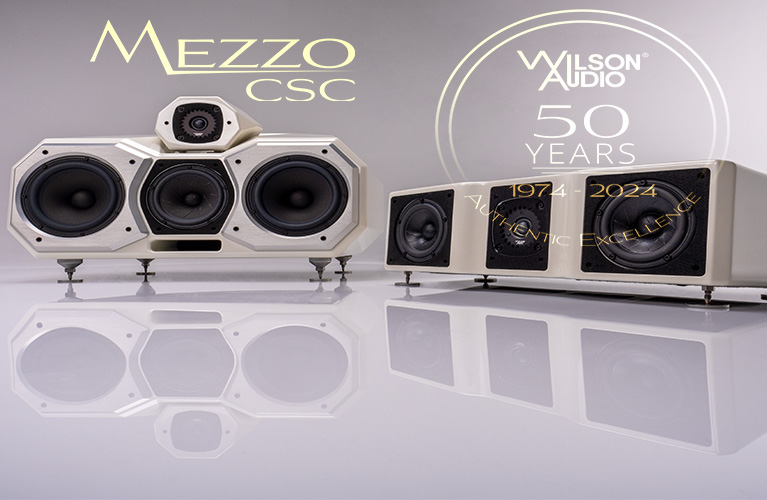The concept of coupling a fully realised monitor speaker and a matching powered low-frequency module, as a cojoined loudspeaker architecture per channel, has been somewhat underapplied in the industry, despite its ample merits. When crafted by a skilled designer, the capabilities of that unified configuration can be manifested through excellent sonic performance. Evidently, young Australian design house Dellichord thoroughly understands the principle. The company has crafted the amplified, uniquely styled FR20 ‘IsoActive Bass Module’, which also serves as a complementary platform for the accompanying FR35 ‘Bookshelf Monitor’ perched above. Dellichord calls it the FR2035 IsoActive system.
Admiration and Inspiration
While not powered, the two cabinet poster child is the hugely successful Wilson Audio WATT/Puppy from the 1980s, an iconic loudspeaker which has maintained and evolved the architecture right up to the current Sasha V. Dellichord has branched the concept on a slightly alternate direction, producing the two-cabinet-per-channel FR2035 IsoActive loudspeaker amplified system. The configuration includes the FR35 Bookshelf Monitor two-way speaker and the FR20 IsoActive Bass Module.
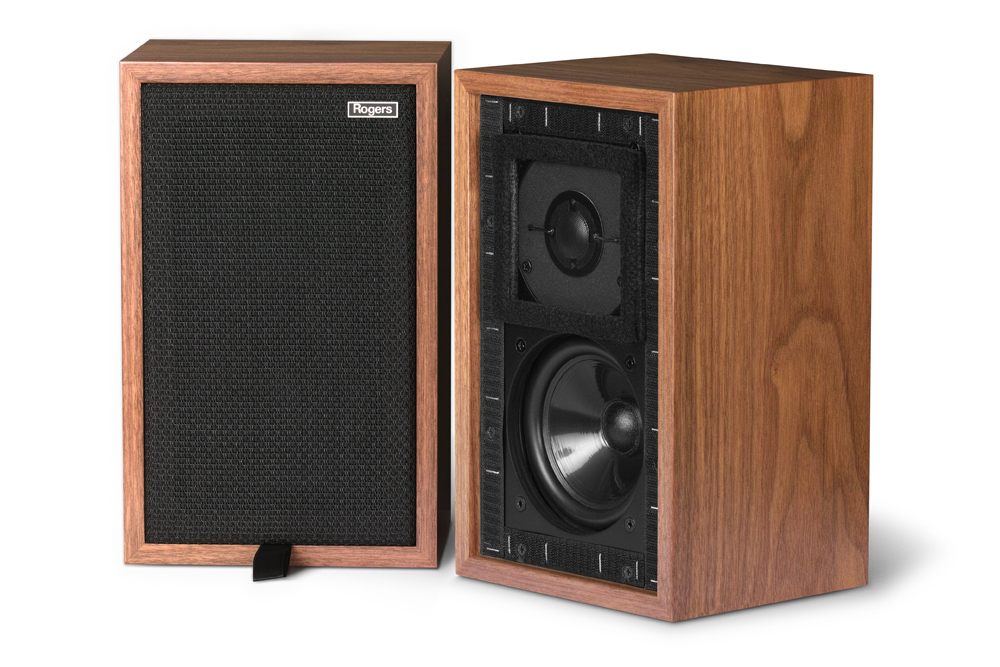 The iconic Rogers LS3/5a
The iconic Rogers LS3/5a
Dellichord founder and designer Andrew Hutchison has an almost nostalgic fondness for classic BBC monitors, and in particular the LS3/5a, a speaker which he admits had its own… character but which, with its beguiling sound, has nevertheless captured his imagination and that of generations of audio enthusiasts.
The FR35 monitor is Hutchison’s homage to that audio classic. However, as other companies have done too (among them Falcon Acoustics, Spendor, Harbeth, and Rogers itself, which I was smitten with – read my review here), Hutchison’s taken the basic architecture of the LS3/5a and has fine-tuned the sonics by employing current drivers, an improved cabinet architecture, modern crossover network components, and updated aesthetics.
Of note, FR35 Bookshelf Monitor was developed in cahoots with Brad Serhan, a renowned Australian loudspeaker engineer. Over several decades, Serhan has designed award winning speaker systems for his own enterprises with Orpheus Loudspeakers and, more recently, Serhan Swift. Serhan has also been solicited by many Australian manufacturers to consult and co-develop numerous acclaimed loudspeaker designs.
The FR35’s tweeter is a 20 mm soft textile dome made by Scan-Speak, featuring a large neodymium magnet system. The mid-bass is handled via a 150 mm “poly hybrid coned premium quality” driver supported by a cast aluminium frame. Said frame is attached to a “super-high density” black sub-baffle which, in turn, is glued to the actual baffle with a special visco-elastic material. The sealed box design uses a “low-order roll-off” which is said to provide a big sound from a small footprint. The dimensions of the FR35 approximate those of the LS3/5a. The FR35’s frequency response spans from 55 Hz to 19 kHz in-room, with a nominal impedance of 6 ohms (4 ohms minimum). The FR35 is a high performance loudspeaker in its own right, which can be used independently of the FR20 low frequency module. This, of course, provides a synergistically proven upgrade path.
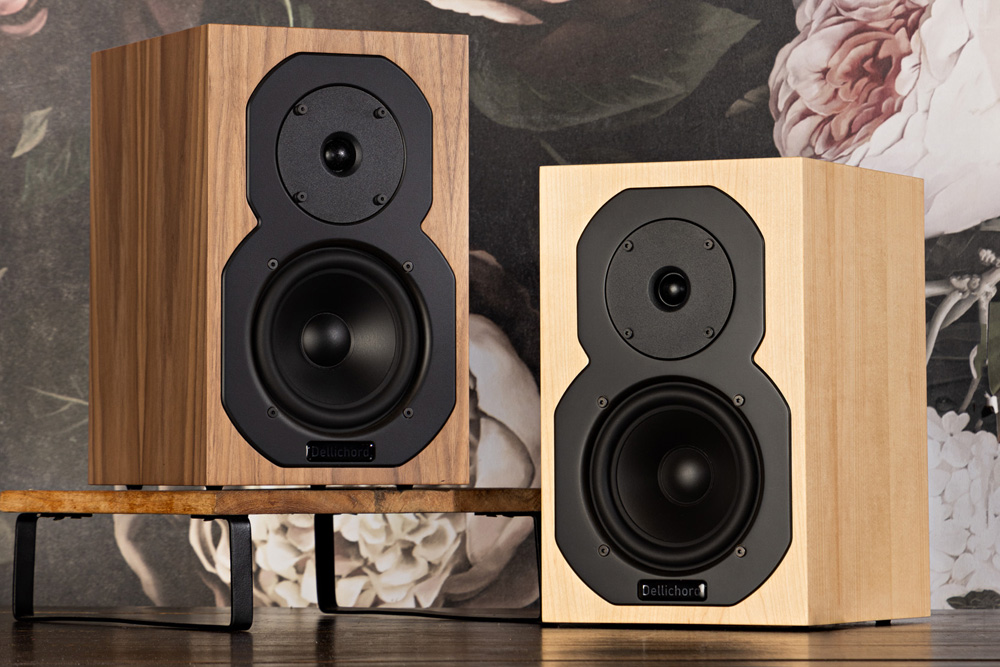
The FR35’s crossover features high quality film capacitors and “P-type cored inductors” all designed and assembled in-house on a high quality, pair-matched fibre-glass circuit board. As part of the FR2035 system, the FR35 is crossed over at approximately 235 Hz (4th order, 24dB/octave) allowing the mid-bass driver to cruise along as, virtually, a pure midrange transducer.
The FR20 IsoActive Bass Module is also a sealed box design which features a unique mounting protrusion for the front-firing woofer. Dellichord calls it an ‘OctoBaffle’ which sits proud of the main module’s cabinet and is the mounting point for one of the two 250 mm natural fibre-coned bass drivers. The second 250 mm woofer is housed internally, in the cabinet proper, in an isobaric configuration within the well-braced, solid enclosure. Both drivers feature a large, high-power magnet system, allowing high output and wide low frequency extension down to below 30 Hz in-room.
The speaker system is driven by an in-built 500 watts RMS, two-channel Hypex Ncore plate amplifier (250 watts per channel) mounted on the FR20’s rear panel. The Hypex amplifier powers both the bass drivers and also the FR35 which interfaces with the FR20 via a set of supplied cable jumpers. The plate amplifier offers an XLR analogue input and output, AES/EBU via XLR input and output, unbalanced RCA Left/Right, S/PDIF via RCA input and output, an optical Toslink input, and a mini-USB for data/computer connectivity. This last connection provides access to computer settings for time alignment and crossover, DSP presets and for further future DSP functionality. From the factory, Dellichord has included three ‘Presets’ offering a neutral position and a bass output adjustment of either -2dB of +2dB to suit a variety of room acoustics. I used the neutral setting, which I found provided exceptional bass output and quality in my room.
Using the FR35 independently as a standalone speaker, of course, means it employs its own high quality crossover network. I tried this over a short period and found the FR35 to be an exceptional standmount monitor with surprising bass and dynamic output given its size, its mid-bass driver dimension, and the sealed box design. Of course, the FR35 sits atop the FR20 and couples to it via a four-armed bracket system. Well, it’s actually decoupled, because the constrained layer bracket is sandwiched between the FR20’s top panel and the FR35’s bottom panel, all linked with a compliant ‘IsoPad’ visco-elastic, footer system. The arrangement converts vibrations into heat, therefore dissipating any distortion between monitor and bass unit.
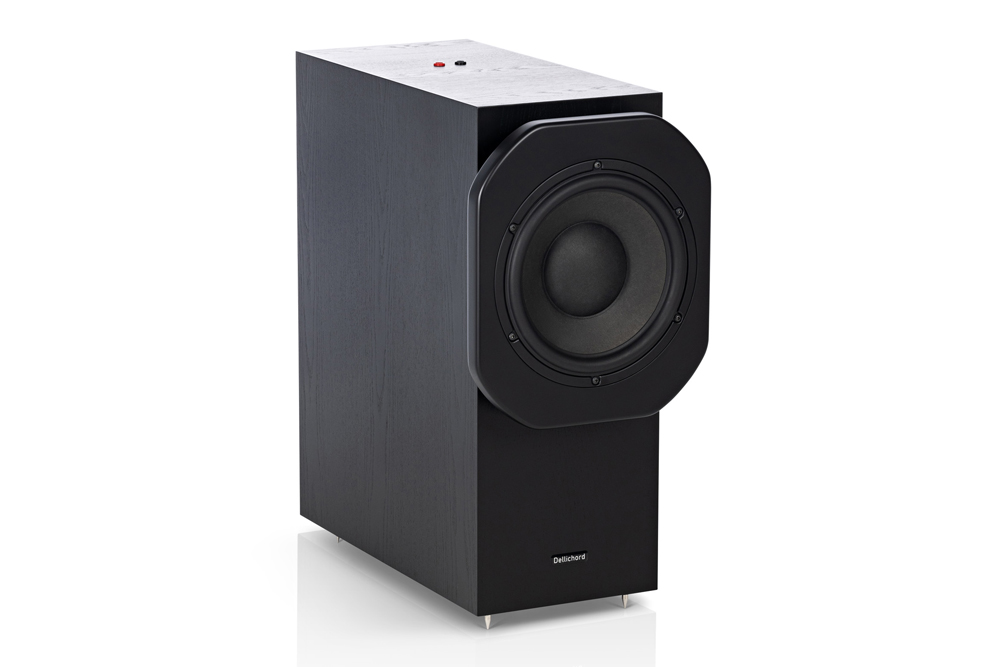
Dellichord provides the FR2035 system with two 3m IEC cables for connecting the FR20 to AC, plus two 3m RCA or XLR “premium quality” signal cables for connecting to your preamplifier or directly to a digital-to-analogue converter with volume control. Dellichord will supply shorter or longer cables where needed.
Being a fan of the iconic Rogers LS3/5a design myself, I was curious to hear Hutchison’s own reasons for his admiration of the small monitor and how he went about differentiating it to the FR35.
We haven't copied really anything that the masters of loudspeaker design did at the BBC in the 70s, but our FR35 is certainly in the spirit of this classic music-maker. We have used the same sized diaphragms and front baffle sizes. We added all the other components mentioned earlier to modernise and perhaps even improve upon what was done back then… it should be possible to improve upon the dynamics and bass extension of the original mini monitor. The question is, can we maintain the musical magic of the original, whilst improving the performance. We certainly believe we have. The FR35 is a charmer on its own… Sit it atop our FR20 powered bass unit and it is transported up a level to a true high end loudspeaker.
I asked Hutchison for some further detail on the FR20 sealed box bass module design.
The FR20 bass system is designed to be sited quite close to a rear wall and take advantage of the boundary reinforcement of lower frequencies. This boundary reinforcement combined with the more relaxed roll off of bass below the corner frequency in a sealed box design assists greatly in allowing the FR20 to reach deep into the subwoofer realm of bass performance. The isobaric aspect of its design improves bass transient performance to some degree and dramatically reduces the requirement for a large enclosure to achieve this bass extension.
The catch is the complexity of the construction required. We believe this is a common reason why most manufacturers of loudspeakers choose not to take advantage of the benefits of an isobaric bass design. Having our own cabinet facility means this is less of an issue for us. We have measured the in-room response of the FR20 bass system in a variety of rooms. Bass extension varies between being flat (-3dB point) down to 27 Hz through to 33 Hz. Most subwoofers the size of the FR20 go somewhat lower than this but we have traded ultimate bass extension for musicality, pace and excitement. We also had to achieve excellent bass sound quality up to 235Hz which requires a different design take than maybe a subwoofer designer who really needs the box to perform no higher than 80Hz.
Of course, the elephant in the room is that unique OctoBaffle design which houses the front-firing 250 mm driver (don’t forget there’s an additional 250 mm driver inside the actual cabinet). I asked Hutchison for his viewpoint.
We were aiming for the smallest footprint possible for maximum bass performance and wished to employ a particular 10 inch driver with parameters that lends itself to a sealed box alignment. Mock ups during the year-long development of the FR2035 idea allowed the design team to understand that an enclosure wide enough for a 10 inch bass unit easily mounted on the front looked, quite frankly, quite wrong. The result always looking like someone had plonked a tiny monitor speaker on top of a small washing machine. We also ended up with an unnecessarily large enclosure.
Being an isobaric bass system meant that the area behind the bass driver played less of a role in its performance so we thought that perhaps we could mount it somewhat remotely. As long as the two isobaric drivers were coupled by the smallest volume of air possible the aerodynamics in that area are less critical. It is important in a non-isobaric design for the area behind the bass unit to be open and not restrictive to air flow as this will affect how the driver performs in a number of key areas. Isobaric combinations do not have the same restrictions. Once we sat the FR35 prototype on top we knew we had unlocked how to build a modular loudspeaker system that avoided the “small box on a big box” look. Other advantages of the OctoBaffle are that it is a very sturdy platform to mount the bass unit on (in) and reduces, to some degree, cabinet diffraction at higher frequencies.
Dellichord has produced a bespoke enclosure with, in the case of the FR35 Bookshelf Monitor, a choice of standard maple or walnut real wood veneers. The FR20 IsoActive Bass Module comes in black ash or satin white finishes. The nicely-finished OctoBaffle is supplied in black only, however, custom colours are available on request, as are veneer finishes for the FR35. In addition to the in-house built cabinets, Dellichord strives to use as many Australian made components as possible. Ergo, the excellent ETI binding posts on the FR35 which accept both banana plugs and spade lugs, the cabinet ID badging, etc.
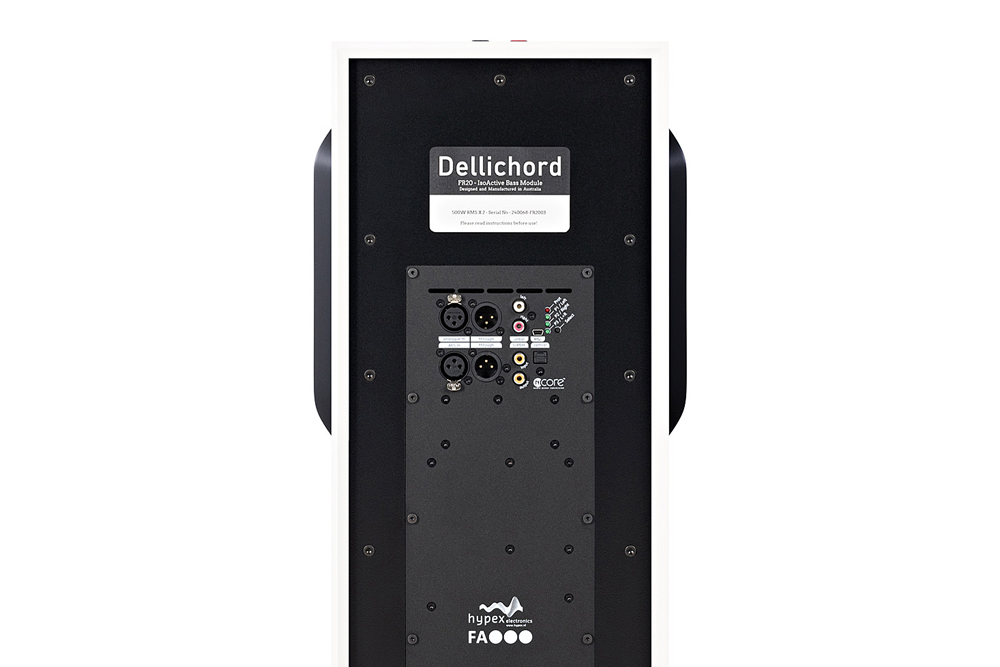
I’ll bring up the subject of local cabinet making again, only because it’s become a rarity in Australia (and globally too, perhaps to a somewhat lesser extent). Most Australian loudspeaker brands use specialists such as Aranmar Acoustics (came to mind first, they may be a few others) who produce cabinets to specification. Or, they concede to the temptation of going to the Far East where, often, the results are fine to start off, only to deteriorate with shortcuts, or omissions, on subsequent production runs (as I’ve been told by several brands).
Credit to Dellichord, given the company’s modest size, in investing in equipment for machining, assembling, and finishing its own beautifully executed cabinets. Veneers are first-class, the enclosures are solid and show excellent overall quality. On the FR20, the OctoBaffle is immaculately machined, its edges are nicely rounded, and the paint application is flawless, all time consuming things that require mature craftsmanship.
Little Big Speakers
The FR2035 speakers were delivered by Andrew Hutchison, who made the trek from sunny Brisbane to SoundStage! Australia’s HQ in the Blue Mountains. Hutchison helped with the setup and made sure things were AOK before leaving me to my leisurely listening. The speakers were placed approximately within an inch of the regular placement where most loudspeakers work in my room. I tweaked the toe-in over a day or so before analytical listening (ended-up so I could see a small section of the FR35’s side panels). I also raised the front spikes around 6 mm or 7 mm, so the speakers tilted back a little. In my room, the tilt-back of the speakers raised the overall soundstage while placing vocals at a more realistic height. The adjustments also produced sharply focused images, netting a very positive outcome in terms of soundfield reproduction.
So, in light of the above, let’s start with the FR2035’s spatial qualities. Despite the fact I would have loved my listening room to have had an extra metre of width (who doesn’t?), the excellent Vicoustic acoustics treatment offers a superbly neutral and spacious sound with well-controlled low-frequencies (see ‘Perfecting a Room’ Feature). I have to say that most well-designed speakers thrive in this environment, producing excellent soundstage information.
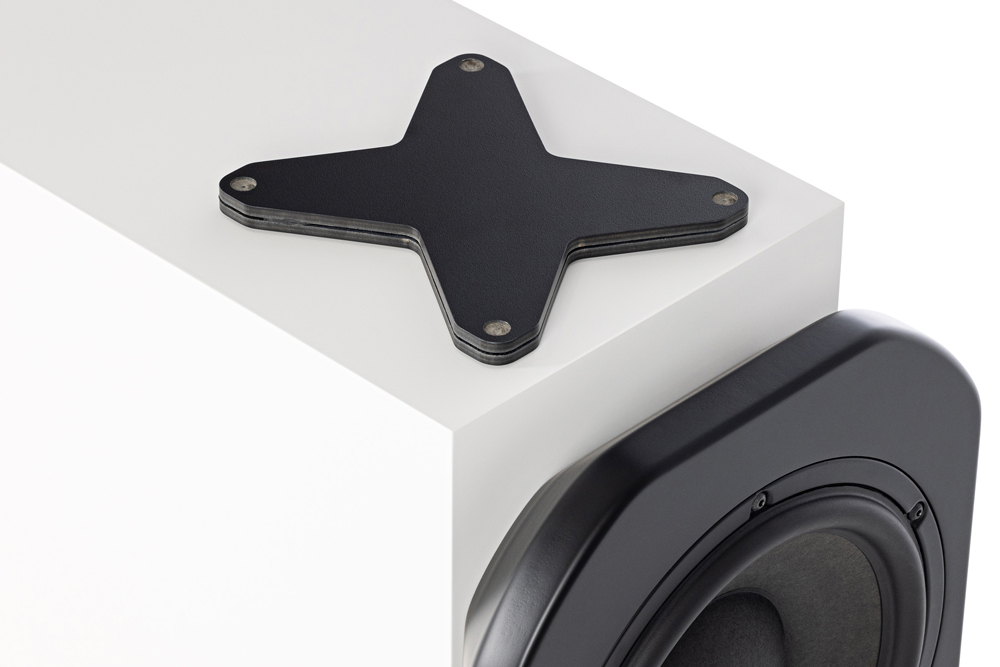
The FR35’s small baffle and quality drivers rendered precise centre stage placement of Agnes Obel within a large, reverberant soundfield on “Familiar” from her Citizen of Glass album. When the male chorus comes in, they’re like apparitions in a cavernous gothic church. The track’s piano intro is beautifully-toned, and the instrument’s reverberations are well reproduced by the quality tweeter.
The freedom the FR35’s midrange sees due to not having to deal with frequencies below 235 Hz allows excellent reproduction of vocals. I loved the immediacy and realness of “I Love You” from Sophie Zelmani’s Soul album. It’s a closely-miked recording, yet sibilance and etch are totally controlled here. Zelmani tends to almost whisper the lyrics, yet she’s given a truthful exposition, with imaging locked-in front-and-centre and just slightly forward of the speakers’ plane.
The same applied to many male vocals I played during my 3.5 weeks with the FR2035 (alas, too short a period, as my review schedule was hectic at the time). Yet another female vocal, I really delighted in the reverberant field reproduced by FR2035 on Mazzy Star’s “Fade Into You” from her classic album So Tonight That I Might See. Hope Sandoval’s delicate voice was well separated from the slide and acoustic guitar licks while the recording venue’s ambience echoed, seemingly, all around.
Referring back to the above Sub-Header, the FR2035 plays big, repudiating its relatively modest dimensions, and delivers a dynamically lively and bass-powerful sound. Remember, as I mentioned above, I set the IsoActive Bass Module in the ‘Neutral’ position – there is further low frequency power available for bass heads or for larger listening environments.
The FR2035 cruised through my bass track tests. Ninad Vasilíc’s “Bass Drops” from the Bass Room album can challenge the low frequencies’ transient attack capabilities of many speakers. If there’s any extra bloom or lack of resolution, this track will brutally expose those flaws. FR2035 presented the inherent detail and the snappy belting in Vasilíc’s bow strikes against the strings, with the speakers also tightly following the finger plucks with nuance and tonal precision right down to the lowest notes. Yet, bass depth and amplitude are compounded with a tight chest-thumping low-end which I found extremely satisfying.
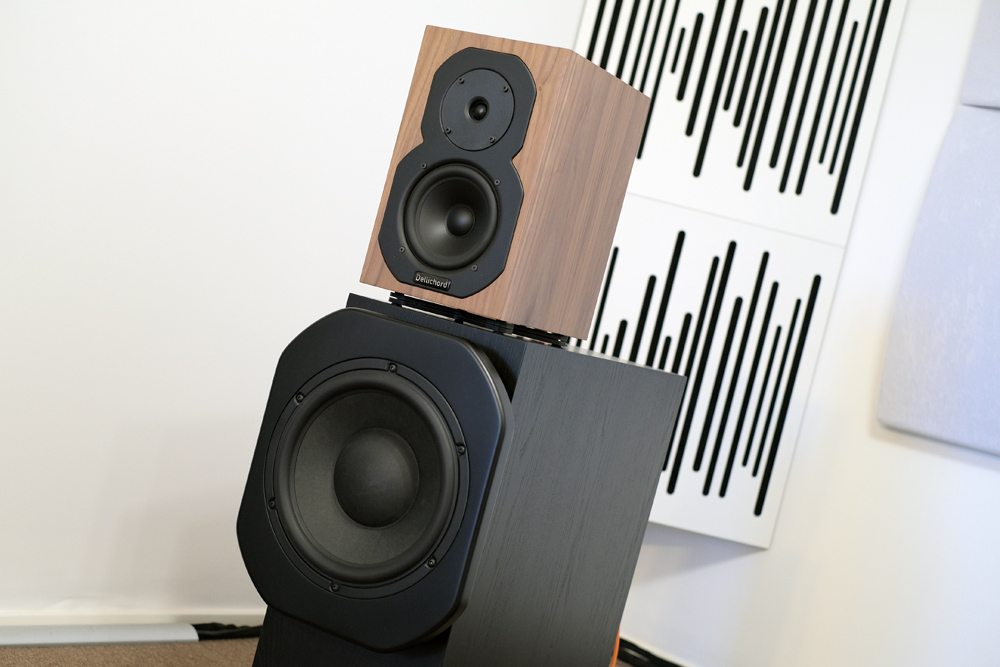
Don’t even with Bass Mekanik’s King of Bass album and the track “Suck My Bass”. This pure guilty pleasure has the low frequencies ramped to 11 (or maybe 12?) and FR2035 tracked it speedily and accurately right down, it would seem, to the Brown Note. The music genre may not be your cup of cha but, if you want to challenge your multi-driver floorstander to its potential limits, then stream the album and play that track in particular. Man, they’ve squeezed some low-end in those ones and zeros. The FR2035 coped with all that rumbling madness with excellent control and stunning depth, sounding way bigger than their size would suggest.
The tonally neutral sonic signature of the FR2035 as a system – more a result of the excellent FR35 monitor through the lovely mids – made for superb reproduction of unamplified acoustic instruments. There was purity in the piano, allowing emotive connection to the devastatingly beautiful “Merry Christmas Mr Lawrence” from Lang Lang’s Piano Book (Encore Edition). Lang Lang undulates the notes from piano to forte and FR2035 tracked both his softness and his vigour seamlessly. The FR2035’s precision allowed finer details to be appreciated when the instrument is played softly, only to then surprise you with the power of the upward dynamic swings.
The same applied to my much loved violin and cello. On the former, the Sibelius Violin Concerto with Pinchas Zuckerman on violin and Daniel Barenboim conducting the London Philharmonic Orchestra, the speakers sounded oh-so-true tonally while also communicating Zuckerman’s technique and the violin’s most delicate nuances. There was no shrillness, no etch, just a superbly balanced presentation. On the latter, the mastery of the cello by Jacqueline Du Pré on the iconic Elgar Cello Concerto conducted by Sir John Barbirolli with the London Symphony Orchestra came through in a way that will just about bring tears to your eyes. The recording’s grandeur, the majesty of the orchestra under the maestro Barbirolli, and Du Pré’s rosin-on-string genius were all metamorphosised from mere playback (in this case vinyl) to almost being in my room. Yes, the FR2035 produced the orchestras within a 3-dimensional soundfield populated with widely spread, self-defined images.
Conclusion
In the audio world there are ample me-too loudspeaker products. You know, off-the-shelf drivers, placed in a fine looking, standard rectangular box… many are designs by the numbers. They do the job, in a… pedestrian, non-offending sort of way, which may, mostly in the short term, be satisfactory.
In contrast, Dellichord is a young company entering the industry with less common, mature designs. The company offers individualistic elements which are not bubble gum but are thoughtfully grounded in technical merits. Importantly and somewhat rare, the immaculately finished cabinetry is built in Queensland, Australia at Dellichord’s own facility while sourcing as much componentry as is practically, and economically possible from local suppliers.
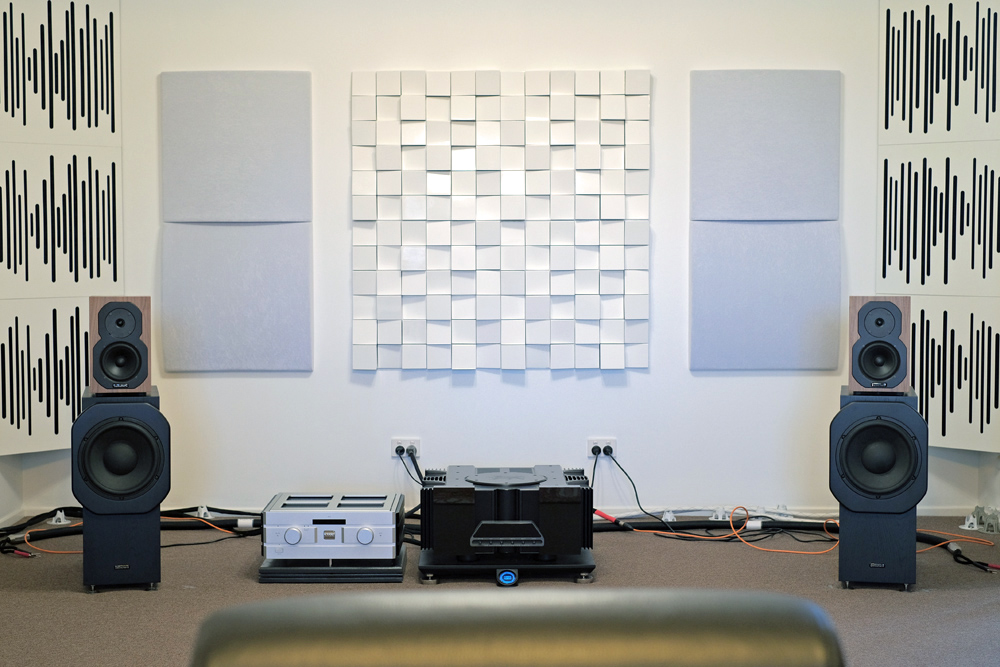
Andrew Hutchison comes from an engineering background (he’s a pilot and has even built his own racing car!) and has extensive past experience as a distributor of fine audio brands. His approach to branding and his awareness of the importance of marketing shows a professionalism which, all things being equal, promises longevity in this super-competitive industry.
With the new FR2035 – a combination of FR35 Bookshelf Monitor and FR20 IsoActive Bass Module – Dellichord jumps onto the stage with an attractive, wide bandwidth speaker. It’s packaged in a practical form which will not overtake listening rooms with ceiling-scraping towers or wide-girth wardrobe-like eccentricities.
The FR2035 sounds dynamic, tonally and spatially precise, refined and offers a deep and powerful low frequency output which, within a prescribed threshold, can be adjusted to the room’s acoustics. Another winning design from Dellichord, a “little Aussie battler” who is, quite evidently, striking all the right chords.
… Edgar Kramer
This email address is being protected from spambots. You need JavaScript enabled to view it.
Associated Equipment
- Speakers — Wilson Audio Alexia V, Axis Loudspeakers VoiceBox S (nearfield monitor), Vermouth Audio Little Luccas Mk.II, Atacama stands
- Amplifier — Gryphon Audio Antileon EVO
- Preamplifier — Supratek Cortese, Totaldac d1-triunity (periodically, direct to amplifier)
- Sources — Digital: 432 EVO Aeon Mk.3 Reference Music Server/Roon Core, Yamaha CD-S2100 transport, Totaldac d1-triunity DAC. Analogue: Transrotor Crescendo with Konstant Studio controller, Reed 1X Tonearm with upgraded internal wiring, Shelter Harmony cartridge, The Funk Firm Houdini cartridge decoupler, Supratek Cortese & REDGUM Audio RGPH2 phono stages
- Processor — DEQX PreMate (part of arsenal/casual use)
- Cables — VYDA Laboratories Orion Silver Reference HFC IC and speaker cables, PSC Audio custom design XLR, Vermouth Audio Reference loom,ZenSati Zorro, Tubulus Concentus USB
- Audio Rack — SGR Audio Statement Model V, Aspire Audio Belgravia amplifier platform (customised for Gryphon Audio Antileon EVO), Stereotech Aluminar Dark 3-tier rack
- Acoustic Treatment — Vicoustic Multifuser Wood, Wavewood Ultra, Cinema Round Premium and Super Bass Extreme
- Miscellaneous — Silent Angel Bonn N8 Pro network switch, GigaWatt PF-1 EVO power strip, Les Davis Audio Viscoelastic CLD discs, Voodoo Cable Iso-Pods, Bocchino Audio Mecado, VRC Vinyl Record Cleaning systemplus miscellaneous accessories
Dellichord FR2035 Active Loudspeakers
Price: FR35 AU$3999, FR2035 (FR35 + FR20) AU$13,999
Australian Warranty: Five Years Manufacturer Warranty
Dellichord Loudspeakers Australia
7/20 Rivergate Place,
Murarrie QLD 4172
Australia
+61 (0) 418 772 434
www.dellichord.com.au






